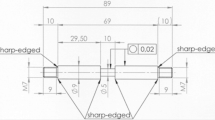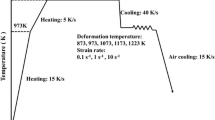Abstract
In this study, a thermo-plastic-martensite transformation coupled model based on the von Mises yield criterion and the associated plastic flow rule is developed to further improve the accuracy of numerical simulation during hot stamping. The constitutive model is implemented into the finite element program ABAQUS using user subroutine VUMAT. The martensite transformation, transformation-induced plasticity and volume expansion during the austenite-to-martensite transformation are included in the constitutive model. For this purpose, isothermal tensile tests are performed to obtain the flow stress, and non-isothermal tensile tests were carried out to validate the constitutive model. The non-isothermal tensile numerical simulation demonstrates that the thermo-plastic-martensite transformation coupled constitutive model provides a reasonable prediction of force-displacement curves upon loading, which is expected to be applied for modeling and simulation of hot stamping.






Similar content being viewed by others
References
H. Karbasian and A.E. Tekkaya: J. Mater. Process. Technol., 2010, vol. 210, pp. 2103–18.
H. Liu, X. Lu, X. Jin, H. Dong, and J. Shi: Scripta Mater., 2011, vol. 64, pp. 749–52.
H. Kim, T. Altan, and Q. Yan: J. Mater. Process. Technol., 2009, vol. 209, pp. 4122–33.
Z. Shi, K. Liu, M. Wang, J. Shi, H. Dong, J. Pu, B. Chi, Y.S. Zhang, and J. Li: Mater. Sci. Eng. A, 2012, vol. 535, pp. 290–96.
Z.X. Gui, W.K. Liang, Y. Liu, and Y.S. Zhang: Mater. Des .2014, vol. 60, pp. 26–33.
H.P. Li, L.F. He, G.Q. Zhao, and L. Zhang: Mater. Sci. Eng. A, 2013, vol. 580, pp. 330–48.
M. Abbasi, M. Naderi, and A. Saeed-Akbari: Metall. Mater. Trans. A, 2013, vol. 44A, pp. 1852–61.
A. Bardelcik, M.J. Worswick, and M.A. Wells: Mater. Des., 2014, vol. 55, pp. 509–25.
P. Åkerström and M. Oldenburg: Model Simul. Mater. Sci., 2007, vol. 15, pp. 105–19.
M. Lee, S. Kim, and H.N. Han: Comput. Mater. Sci., 2009, vol. 47, pp. 556–67.
X. Chen, N. Xiao, D. Li, G. Li and G. Sun: Modell. Simul. Mater. Sci. Eng., 2014, vol. 22, pp. 065005–21.
A. Abdollahpoor, X. Chen, M.P. Pereira, and N. Xiao. J. Mater. Process. Technol., 2016, vol. 228, pp. 125–36.
A. Blaise, B. Bourouga, B. Abdulhay, and C. Dessain: Appl. Therm. Eng. 2013, vol. 61, pp. 141–48.
J.B. Leblond: Int. J. Plast., 1989, vol. 5, pp. 551–71.
J.B. Leblond: Int. J. Plast., 1989, vol. 5, pp. 573–93.
M. Lee, S. Kim, H.N. Han, and W.C. Jeong: Int. J. Plast., 2009, vol. 25, pp. 1726–58.
A. Tahimi, F. Barbe, L. Taleb, and S. Meftah: Comput. Mater. Sci., 2012, vol. 64, pp. 25–29.
L. Taleb and F.O. Sidoroff: Int. J. Plast., 2003, vol. 19, pp. 1821–42.
J.Q. Tan, M. Zhan, S. Liu, T. Huang, J. Guo, and H. Yang: Mater. Sci. Eng. A, 2015, vol. 631, pp. 214–19.
S.D. Norris and I. Wilson: Model. Simul. Mater. Sci. Eng., 1999, vol. 7, pp. 297–309.
P. Åkerström and M Oldenburg: J. Mater. Process. Technol., 2006, vol. 174, pp. 399–406.
S.J. Lee, E.J. Pavlina, and C.J.V. Tyne: Mater. Sci. Eng. A, 2010, vol. 527, pp. 3186–94.
M. Naderia, L. Durrenberger, A. Molinari, W. Bleck: Mater. Sci. Eng. A, 2008, vol. 478, pp. 130–39.
M. Eriksson, M. Oldenburg, M.C. Somani, and L.P. Karjalainen: Model. Simul. Mater. Sci. Eng., 2002, vol. 10, pp. 277–94.
Acknowledgments
This research work is financially supported by the National Natural Science Foundation of China (Grant No. 51275185) and National Natural Science Foundation of China (Grant No. 51405171). The authors would like to acknowledge the State Key Lab of Materials Processing and Die and Mould Technology for their assistance in the tensile experiments.
Author information
Authors and Affiliations
Corresponding author
Additional information
Manuscript submitted June 30, 2016.
Rights and permissions
About this article
Cite this article
Bin, Z., WeiKang, L., Zhongxiang, G. et al. A Thermo-Plastic-Martensite Transformation Coupled Constitutive Model for Hot Stamping. Metall Mater Trans A 48, 1375–1382 (2017). https://doi.org/10.1007/s11661-016-3884-x
Received:
Published:
Issue Date:
DOI: https://doi.org/10.1007/s11661-016-3884-x




